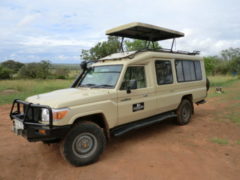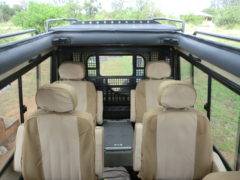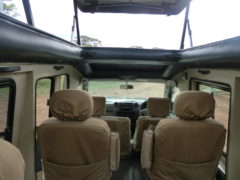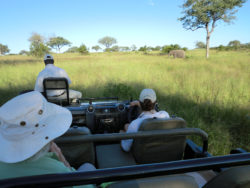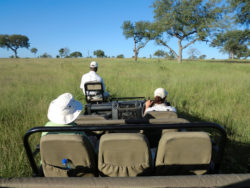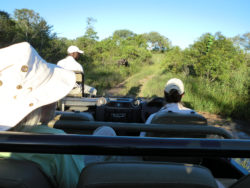Many people are unaware that the types of vehicles typically used for wildlife viewing safaris in eastern Africa differ from those used in southern Africa.
In eastern Africa (namely Kenya, Rwanda, Tanzania and Uganda) you will typically find closed safari vehicles including the ubiquitous minibus’s. As these countries have extensive road networks many safaris are conducted with a driver and vehicle which stay with you from the moment you arrive to the time you depart. Closed vehicles are not ideal for wildlife viewing (which I will explain below) but their use in eastern Africa on road based safaris makes sense as travelers would not want to drive for hours, at speed, along paved highways and on dirt roads – in an open vehicle subjected to wind, rain, cold, heat, and dust.
Looking more closely at safari vehicles in eastern Africa I will focus on Tanzania which has the region’s best wildlife viewing. Closed safari vehicles in Tanzania typically take up to 6 guests in 3 rows of seating with a pop-top roof hatch which is raised for wildlife viewing (see photos). They can be minibuses (which in some areas are more abundant than the wildlife) or 4×4 Land Cruisers or 4×4 Land Rovers. At Ultimate Africa we do not book minibuses for clients.
For wildlife viewing you stand and pop your head and shoulders through the hatch. If you don’t wish to stand you can open a window although on Land Cruisers and Land Rovers the sliding windows can be quite small. Also note that most safari vehicles in eastern Africa are fitted with internal framing which can get in the way of moving around within the vehicle and viewing game. Closed vehicles can also become very hot as they often do not have AC. One bonus with the closed vehicles used for long road based safaris – they often have a small fridge (although the noise can be distracting when watching animals). Open safari vehicles typically have a cooler filled with ice and drinks.
Tanzania now has good value, reliable, light airplane service which can fly guest’s to their specific safari lodges and camps – this saves a tremendous amount of driving time (as an example you can fly 1.5 hours from Arusha to the Serengeti rather than driving 12 hours). It allows many of these properties to offer open safari vehicles. As you will see below, when it comes to wildlife viewing, open vehicles are the way to go and Tanzanian properties that offer them are high on our list of places to stay!
When flying between our preferred Tanzanian safari camps and lodges you will use their open vehicles and their resident guides who know what the animals in the area are up to and where to find them. Guides based in towns such as Arusha (near Kilimanjaro Airport where many Tanzania visitors arrive), who conduct road based safaris, often have no clue what is happening wildlife wise in an area. While driving they will call other guides (either by radio or on their cell phone) for updates. Upon arrival at each safari camp or lodge they will ask the resident guides what is going on. I have also gotten lost with Arusha based guides as they are not out in remote areas every day and don’t know which roads are best to use.
If you opt for a road based safari in Tanzania you will have the benefit of a private vehicle for yourself but you will not be able to partake in open vehicle game drives at the camps and lodges that offer them without paying additional surcharge (on a road based safari you have your own vehicle and guide and therefore pay a lower nightly rate at each property as you are not using the property’s guides / vehicles). When using a lodge or camps open vehicle, with their guide, you typically share the vehicle with other guests who are also staying at the property. If you prefer to have exclusive use of an open vehicle this needs to be arranged, at extra cost, in advance.
At Ngorongoro Crater, a must see for many visitors to Tanzania, all of the safari vehicles are closed. Guests visiting the crater will land 50 miles away at the Lake Manyara Airstrip and then transfer by road 1 hour to their accommodations on the crater rim. The crater rim, at 7,500 feet, is often cool and drizzly – hidden in clouds / fog making arrival by plane impossible. As the vehicles that are used to transfer guests are the same that are used for wildlife viewing they are closed for guest comfort.
In southern Africa open vehicles are the norm and minibus’s are rarely seen. Most safaris in Botswana, Namibia, South Africa, Zambia and Zimbabwe are conducted in open sided 4×4 vehicles – Land Cruisers and Land Rovers. Road based safaris are not common and in some countries, such as Botswana where the road networks are very limited, flying between safari properties makes much more sense… in some parts of Botswana a 20 minute flight can save over 24 hours of very slow, remote wilderness, driving.
When on safari in an open vehicle there is nothing between you and Africa’s wilderness and wildlife. Sounds are more easily heard, smells are easier to pick up, and most importantly it is far easier to take photos and follow animals as they move around.
Seating is tiered with 3 rows typically taking no more than 6 guests – 2 guests per row. For guests who wish to sit up front next to the guide this is often possible… simply ask. Vehicles are shared with other guests from the camp or lodge where you are staying. If you prefer to have exclusive use of an open vehicle this needs to be arranged, at extra cost, in advance.
Although completely open on the sides many open vehicles normally have permanent sun shades which also help keep you dry if you get caught in the odd rainstorm. Note: If you are at a safari camp or lodge and it is dumping with rain most guides don’t recommend game drives in either type of vehicle – you generally see little game and the vehicles can really tear up the roads and natural areas. The chances of getting stuck are also much higher. Some safari properties have fitted roll down clear plastic windows to be used in the event of rains. Once rolled down and snapped / zipped / velcroed into place they are impossible to see through and often fog up… more trouble than they are worth.
Some open vehicles have a fold down seat attached to the front bumper for a tracker to sit on. In my opinion having a tracker up front makes no difference in spotting game. In addition upon encountering predators such as lion and leopard your guide will need to stop as the tracker will need to climb into the front seat next to the guide.
I have been going on safari for 20 years now and I cannot recall one person who has ever said they prefer a closed vehicle for wildlife viewing.
Where to sit in the safari vehicle? The most comfortable, least bouncy seats are up front or in the first row of seats… the last row, especially appealing in open vehicles where the seating is tiered, is by far the bounciest. Back problems – sit up front… you will be much happier!
One last consideration when planning an African safari. When on a road based safari the weight and size of your luggage is not as important as when on a flying safari. Within eastern Africa most light air transfers limit guests to 15 kilograms (33 pounds) of luggage packed in a soft bag. In southern Africa most light air transfers are limit travelers to 20 kilograms (44 pounds) of luggage packed in a soft bag or bags. As a point of reference when I travel my duffel bag weighs near 17 to 20 pounds including clothing and shoes. My carryon, often a backpack or other smaller bag, holds my computer, camera, phone, chargers, toiletries and such… it weighs close to 15 pounds. I readily admit that after traveling to Africa several times a year for 20 years I do have the packing down to an art (both Lorna and I include packing tips, so you too can travel lightly, in the predeparture information we provide to all clients upon booking.
Stay well,
Ian Proctor
Ultimate Africa founder and president
